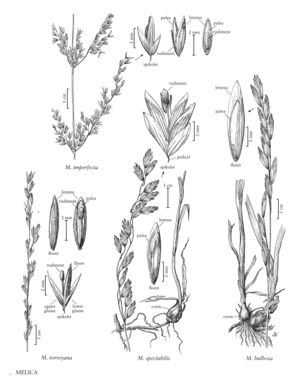Difference between revisions of "Melica bulbosa"
FNA>Volume Importer |
FNA>Volume Importer |
||
| Line 26: | Line 26: | ||
-->{{Treatment/Body | -->{{Treatment/Body | ||
|distribution=Colo.;Wash.;Tex.;Wyo.;Utah;Calif.;Oreg.;Mont.;B.C.;Sask.;Idaho;Nev.;S.Dak. | |distribution=Colo.;Wash.;Tex.;Wyo.;Utah;Calif.;Oreg.;Mont.;B.C.;Sask.;Idaho;Nev.;S.Dak. | ||
| − | |discussion=<p | + | |discussion=<p>Melica bulbosa grows from 1370-3400 m, mostly in open woods on dry, well-drained slopes and along streams. It is restricted to the western half of the Flora region. Two records from Texas, in Jeff Davis and Sutton counties, have not been verified.</p><!-- |
| − | --><p | + | --><p>Melica bulbosa differs from M. spectabilis in its sessile corm and longer glumes. In addition, in M. bulbosa the spikelets have purplish bands which appear to be concentrated towards the apices; in M. spectabilis the bands appear more regularly spaced. It differs from M. californica in its more narrowly acute spikelets, more strongly colored lemmas, and lack of corms, and from M. fugax in not having swollen rachilla internodes.</p> |
|tables= | |tables= | ||
|references= | |references= | ||
| Line 43: | Line 43: | ||
|basionyms= | |basionyms= | ||
|family=Poaceae | |family=Poaceae | ||
| + | |illustrator=Linda A. Vorobik | ||
|distribution=Colo.;Wash.;Tex.;Wyo.;Utah;Calif.;Oreg.;Mont.;B.C.;Sask.;Idaho;Nev.;S.Dak. | |distribution=Colo.;Wash.;Tex.;Wyo.;Utah;Calif.;Oreg.;Mont.;B.C.;Sask.;Idaho;Nev.;S.Dak. | ||
|reference=None | |reference=None | ||
| Line 48: | Line 49: | ||
|publication year= | |publication year= | ||
|special status= | |special status= | ||
| − | |source xml=https:// | + | |source xml=https://bibilujan@bitbucket.org/aafc-mbb/fna-data-curation.git/src/314eb390f968962f596ae85f506b4b3db8683b1b/coarse_grained_fna_xml/V24/V24_109.xml |
|subfamily=Poaceae subfam. Pooideae | |subfamily=Poaceae subfam. Pooideae | ||
|tribe=Poaceae tribe Meliceae | |tribe=Poaceae tribe Meliceae | ||
Revision as of 16:05, 30 October 2019
Plants loosely cespitose, rhizomatous. Culms 29-100 cm, forming corms, corms almost sessile on the connecting rhizomes; internodes scabridulous above the nodes. Sheaths usually scab¬ridulous, sometimes sparsely pilose; ligules 2-6 mm; blades 1.5-5 mm wide, abaxial surfaces scabridulous, adaxial surfaces with hairs. Panicles 7-30 cm; branches 2-6.5 cm, appressed, usually straight, with 1-5 spikelets; pedicels straight; disarticulation above the glumes. Spikelets 6-24 mm, with 4-7 bisexual florets, base of the distal florets concealed at anthesis; rachilla internodes 1-2 mm, not swollen when fresh, not wrinkled when dry. Glumes from (1/2)2/3 as long as to equaling the spikelets; lower glumes 5.5-10.5 mm long, 2-3 mm wide, 3-5-veined; upper glumes 6-14 mm long, 2.3-3.5 mm wide, 5-7-veined; lemmas 6-12 mm, glabrous, smooth or scabrous, 7-11-veined, veins prominent, apices emarginate to acute, unawned; paleas about 3/4 the length of the lemmas; anthers 3, 1.5-4 mm; rudiments 1.5-5 mm, truncate to tapering, sometimes resembling the bisexual florets in shape. 2n =18.
Distribution
Colo., Wash., Tex., Wyo., Utah, Calif., Oreg., Mont., B.C., Sask., Idaho, Nev., S.Dak.
Discussion
Melica bulbosa grows from 1370-3400 m, mostly in open woods on dry, well-drained slopes and along streams. It is restricted to the western half of the Flora region. Two records from Texas, in Jeff Davis and Sutton counties, have not been verified.
Melica bulbosa differs from M. spectabilis in its sessile corm and longer glumes. In addition, in M. bulbosa the spikelets have purplish bands which appear to be concentrated towards the apices; in M. spectabilis the bands appear more regularly spaced. It differs from M. californica in its more narrowly acute spikelets, more strongly colored lemmas, and lack of corms, and from M. fugax in not having swollen rachilla internodes.
Selected References
None.
